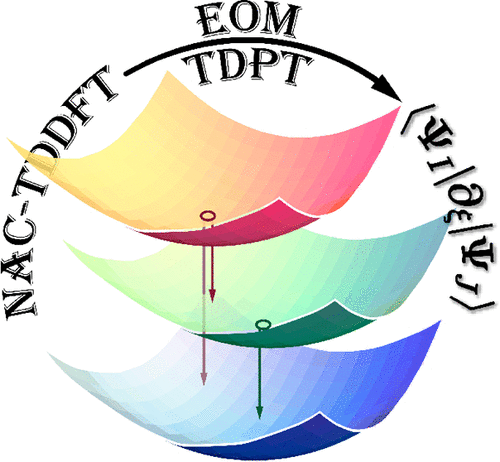当前位置:
X-MOL 学术
›
Acc. Chem. Res.
›
论文详情
Our official English website, www.x-mol.net, welcomes your
feedback! (Note: you will need to create a separate account there.)
NAC-TDDFT: Time-Dependent Density Functional Theory for Nonadiabatic Couplings
Accounts of Chemical Research ( IF 16.4 ) Pub Date : 2021-08-27 , DOI: 10.1021/acs.accounts.1c00312 Zikuan Wang 1 , Chenyu Wu 1 , Wenjian Liu 1
Accounts of Chemical Research ( IF 16.4 ) Pub Date : 2021-08-27 , DOI: 10.1021/acs.accounts.1c00312 Zikuan Wang 1 , Chenyu Wu 1 , Wenjian Liu 1
Affiliation

|
First-order nonadiabatic coupling (NAC) matrix elements (fo-NACMEs) are the basic quantities in theoretical descriptions of electronically nonadiabatic processes that are ubiquitous in molecular physics and chemistry. Given the large size of systems of chemical interests, time-dependent density functional theory (TDDFT) is usually the first choice of methods. However, the lack of many-electron wave functions in TDDFT renders the formulation of NAC-TDDFT for fo-NACMEs conceptually difficult. Because of this, various variants of NAC-TDDFT have been proposed in the literature from different standing points, including the Hellmann–Feynman-like expression and auxiliary/pseudo-wave function (AWF)-, equation-of-motion (EOM)-, and time-dependent perturbation theory (TDPT)-based formulations. Based on critical analyses, the following conclusions are made here: (1) The Hellmann–Feynman-like expression, which is rooted in exact wave function theory, is hardly useful due to huge demand on basis sets. (2) Although most popular, the AWF variants of NAC-TDDFT are not theoretically founded and become ambiguous particularly for the fo-NACMEs between two excited states, although they do agree with the EOM and TDPT variants under the Tamm–Dancoff approximation. (3) The TDPT variant of NAC-TDDFT is theoretically most rigorous but suffers from numerical instabilities on the one hand and does not differ to a significant extent from the EOM variant on the other hand. (4) As such, the EOM variant of NAC-TDDFT for the fo-NACMEs between the ground and excited states and between two excited states is solely the right choice in practice. These formal analyses are fully supported by numerical experimentations, taking azulene as a showcase. The proper implementation of the EOM variant of NAC-TDDFT is also highlighted, showing that the fo-NACMEs between the ground and excited states and between two excited states are computationally very much the same as the analytic energy gradients of DFT and TDDFT, respectively. Possible future developments of the EOM variant of NAC-TDDFT are also highlighted. Its extensions to spin-adapted open-shell TDDFT and proper treatment of spin–orbit couplings (which are another source of force for electronically nonadiabatic processes) are particularly warranted in the near future.
中文翻译:

NAC-TDDFT:非绝热耦合的瞬态密度泛函理论
一阶非绝热耦合 (NAC) 矩阵元素 (fo-NACME) 是分子物理和化学中普遍存在的电子非绝热过程的理论描述中的基本量。鉴于化学兴趣系统的规模很大,时间相关密度泛函理论 (TDDFT) 通常是方法的首选。然而,TDDFT 中缺乏多电子波函数使得 fo-NACME 的 NAC-TDDFT 公式在概念上很困难。正因为如此,文献中已经从不同的立场提出了 NAC-TDDFT 的各种变体,包括类 Hellmann-Feynman 表达式和辅助/伪波函数 (AWF)-、运动方程 (EOM)- ,以及基于时间相关微扰理论 (TDPT) 的公式。基于批判性分析,这里得出以下结论: (1) 根植于精确波函数理论的类赫尔曼-费曼表达式由于对基组的巨大需求而几乎没有用。(2) 尽管最受欢迎,但 NAC-TDDFT 的 AWF 变体在理论上并没有建立,并且特别对于两个激发态之间的 fo-NACME 变得模糊不清,尽管它们确实与 Tamm-Dancoff 近似下的 EOM 和 TDPT 变体一致。(3) NAC-TDDFT 的 TDPT 变体在理论上是最严格的,但一方面存在数值不稳定性,另一方面与 EOM 变体没有显着差异。(4) 因此,用于基态和激发态之间以及两个激发态之间的 fo-NACME 的 NAC-TDDFT 的 EOM 变体在实践中完全是正确的选择。这些正式的分析得到了数值实验的充分支持,并以花青素为例。还强调了 NAC-TDDFT 的 EOM 变体的正确实现,表明基态和激发态之间以及两个激发态之间的 fo-NACME 在计算上与 DFT 和 TDDFT 的解析能量梯度分别非常相似。还强调了 NAC-TDDFT 的 EOM 变体未来可能的发展。在不久的将来,它对适应自旋的开壳 TDDFT 的扩展以及对自旋轨道耦合(这是电子非绝热过程的另一个力源)的适当处理特别有必要。表明基态和激发态之间以及两个激发态之间的 fo-NACME 在计算上分别与 DFT 和 TDDFT 的解析能量梯度非常相似。还强调了 NAC-TDDFT 的 EOM 变体未来可能的发展。在不久的将来,它对适应自旋的开壳 TDDFT 的扩展以及对自旋轨道耦合(这是电子非绝热过程的另一个力源)的适当处理特别有必要。表明基态和激发态之间以及两个激发态之间的 fo-NACME 在计算上分别与 DFT 和 TDDFT 的解析能量梯度非常相似。还强调了 NAC-TDDFT 的 EOM 变体未来可能的发展。在不久的将来,它对适应自旋的开壳 TDDFT 的扩展以及对自旋轨道耦合(这是电子非绝热过程的另一个力源)的适当处理特别有必要。
更新日期:2021-09-07
中文翻译:

NAC-TDDFT:非绝热耦合的瞬态密度泛函理论
一阶非绝热耦合 (NAC) 矩阵元素 (fo-NACME) 是分子物理和化学中普遍存在的电子非绝热过程的理论描述中的基本量。鉴于化学兴趣系统的规模很大,时间相关密度泛函理论 (TDDFT) 通常是方法的首选。然而,TDDFT 中缺乏多电子波函数使得 fo-NACME 的 NAC-TDDFT 公式在概念上很困难。正因为如此,文献中已经从不同的立场提出了 NAC-TDDFT 的各种变体,包括类 Hellmann-Feynman 表达式和辅助/伪波函数 (AWF)-、运动方程 (EOM)- ,以及基于时间相关微扰理论 (TDPT) 的公式。基于批判性分析,这里得出以下结论: (1) 根植于精确波函数理论的类赫尔曼-费曼表达式由于对基组的巨大需求而几乎没有用。(2) 尽管最受欢迎,但 NAC-TDDFT 的 AWF 变体在理论上并没有建立,并且特别对于两个激发态之间的 fo-NACME 变得模糊不清,尽管它们确实与 Tamm-Dancoff 近似下的 EOM 和 TDPT 变体一致。(3) NAC-TDDFT 的 TDPT 变体在理论上是最严格的,但一方面存在数值不稳定性,另一方面与 EOM 变体没有显着差异。(4) 因此,用于基态和激发态之间以及两个激发态之间的 fo-NACME 的 NAC-TDDFT 的 EOM 变体在实践中完全是正确的选择。这些正式的分析得到了数值实验的充分支持,并以花青素为例。还强调了 NAC-TDDFT 的 EOM 变体的正确实现,表明基态和激发态之间以及两个激发态之间的 fo-NACME 在计算上与 DFT 和 TDDFT 的解析能量梯度分别非常相似。还强调了 NAC-TDDFT 的 EOM 变体未来可能的发展。在不久的将来,它对适应自旋的开壳 TDDFT 的扩展以及对自旋轨道耦合(这是电子非绝热过程的另一个力源)的适当处理特别有必要。表明基态和激发态之间以及两个激发态之间的 fo-NACME 在计算上分别与 DFT 和 TDDFT 的解析能量梯度非常相似。还强调了 NAC-TDDFT 的 EOM 变体未来可能的发展。在不久的将来,它对适应自旋的开壳 TDDFT 的扩展以及对自旋轨道耦合(这是电子非绝热过程的另一个力源)的适当处理特别有必要。表明基态和激发态之间以及两个激发态之间的 fo-NACME 在计算上分别与 DFT 和 TDDFT 的解析能量梯度非常相似。还强调了 NAC-TDDFT 的 EOM 变体未来可能的发展。在不久的将来,它对适应自旋的开壳 TDDFT 的扩展以及对自旋轨道耦合(这是电子非绝热过程的另一个力源)的适当处理特别有必要。











































 京公网安备 11010802027423号
京公网安备 11010802027423号